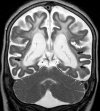Aicardi-Goutieres syndrome: neuroradiologic findings and follow-up
- PMID: 19628626
- PMCID: PMC7051307
- DOI: 10.3174/ajnr.A1694
Aicardi-Goutieres syndrome: neuroradiologic findings and follow-up
Abstract
Background and purpose: To date, few studies have focused specifically on imaging findings in Aicardi-Goutières syndrome (AGS). We set out to evaluate retrospectively neuroradiologic data from a large sample of patients with AGS, focusing on the pattern of white matter abnormalities and the temporal evolution of the cerebral involvement to establish the radiologic natural history of the disease.
Materials and methods: Thirty-six patients, 18 girls and 18 boys, were included. All had a clinical diagnosis of AGS, genetically confirmed in 31 of them. For every subject, we reviewed at least 1 CT and 1 MR imaging study; 19 (52.7%) had multiple examinations. In all, we reviewed 109 examinations. Clinical-neuroradiologic comparisons were analyzed by using the chi(2) test.
Results: Calcifications were found in all subjects, mainly in the basal ganglia, lobar white matter, and dentate nuclei. Abnormal white matter was present in all the subjects, showing 2 patterns of distribution: diffuse in 18 (50%) and an anteroposterior gradient in 18 (50%). Cystic areas were observed in the temporal and/or frontal lobes in 12/36 patients (33.3%). A correlation was found between early age at onset and severity of the leukoencephalopathy in the frontal (P = .024) and temporal (P = .034) regions. A significant degree of cerebral atrophy was found in 31/36 subjects (86.1%). The neuroradiologic presentation remained substantially stable with time.
Conclusions: The different neuroradiologic presentations of AGS are here outlined for the first time in a large sample of patients. These findings may facilitate more precise and earlier diagnosis of this rare but probably underdiagnosed syndrome.
Figures




Comment in
-
Reconciling neuroimaging and clinical findings in Aicardi-Goutières syndrome: an autoimmune-mediated encephalopathy.AJNR Am J Neuroradiol. 2010 Aug;31(7):E62-3; author reply E64. doi: 10.3174/ajnr.A2147. Epub 2010 Jun 25. AJNR Am J Neuroradiol. 2010. PMID: 20581073 Free PMC article. No abstract available.
Similar articles
-
Neuroradiologic patterns and novel imaging findings in Aicardi-Goutières syndrome.Neurology. 2016 Jan 5;86(1):28-35. doi: 10.1212/WNL.0000000000002228. Epub 2015 Nov 18. Neurology. 2016. PMID: 26581299 Free PMC article.
-
Regression of white matter hypodensities with age in Aicardi-Goutierés syndrome: a case report.Childs Nerv Syst. 2006 Nov;22(11):1503-6. doi: 10.1007/s00381-006-0112-9. Epub 2006 Jun 27. Childs Nerv Syst. 2006. PMID: 16802170
-
Aicardi-Goutières syndrome: neuroradiological findings after nine years of follow-up.Eur J Paediatr Neurol. 2004;8(5):243-6. doi: 10.1016/j.ejpn.2004.06.003. Eur J Paediatr Neurol. 2004. PMID: 15341906
-
Aicardi-Goutières syndrome: differential diagnosis and aetiopathogenesis.Funct Neurol. 2003 Apr-Jun;18(2):71-5. Funct Neurol. 2003. PMID: 12911136 Review.
-
Aicardi-Goutieres syndrome.Br Med Bull. 2009;89:183-201. doi: 10.1093/bmb/ldn049. Epub 2009 Jan 7. Br Med Bull. 2009. PMID: 19129251 Review.
Cited by
-
Peripheral inflammation is associated with micro-structural and functional connectivity changes in depression-related brain networks.Mol Psychiatry. 2021 Dec;26(12):7346-7354. doi: 10.1038/s41380-021-01272-1. Epub 2021 Sep 17. Mol Psychiatry. 2021. PMID: 34535766 Free PMC article.
-
Basal ganglia calcifications (Fahr's syndrome): related conditions and clinical features.Neurol Sci. 2019 Nov;40(11):2251-2263. doi: 10.1007/s10072-019-03998-x. Epub 2019 Jul 2. Neurol Sci. 2019. PMID: 31267306 Free PMC article. Review.
-
A novel phosphoproteomic landscape evoked in response to type I interferon in the brain and in glial cells.J Neuroinflammation. 2021 Oct 16;18(1):237. doi: 10.1186/s12974-021-02277-x. J Neuroinflammation. 2021. PMID: 34656141 Free PMC article.
-
The clinical and genetic spectrum of primary familial brain calcification.J Neurol. 2023 Jun;270(6):3270-3277. doi: 10.1007/s00415-023-11650-0. Epub 2023 Mar 2. J Neurol. 2023. PMID: 36862146 Free PMC article.
-
Evidence of blood-brain barrier dysfunction and CSF immunoglobulin synthesis in Down Syndrome Regression Disorder.Ann Clin Transl Neurol. 2025 Apr;12(4):805-820. doi: 10.1002/acn3.52299. Epub 2025 Feb 25. Ann Clin Transl Neurol. 2025. PMID: 39996411 Free PMC article.
References
-
- Aicardi J, Goutières F. A progressive familial encephalopathy in infancy with calcifications of the basal ganglia and chronic cerebrospinal fluid lymphocytosis. Ann Neurol 1984;15:49–54 - PubMed
-
- Goutières F, Aicardi J, Barth PG, et al. Aicardi–Goutières syndrome: an update and results of interferon-alpha studies. Ann Neurol 1998;44:900–07 - PubMed
-
- Lanzi G, Fazzi E, D'Arrigo S, et al. The natural history of Aicardi–Goutières syndrome: follow-up of 11 Italian patients. Neurology 2005;64:1621–24 - PubMed
-
- Goutières F. Aicardi-Goutières syndrome. Brain Dev 2005;27:201–06 - PubMed
MeSH terms
LinkOut - more resources
Full Text Sources
Medical
